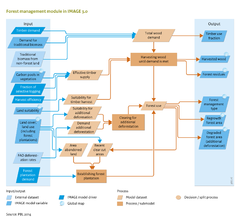Forest management: Difference between revisions
Jump to navigation
Jump to search
m (Text replace - "ExternalModel=" to "Model-Database=") |
No edit summary |
||
| Line 1: | Line 1: | ||
{{ComponentTemplate2 | {{ComponentTemplate2 | ||
|Application=Rethinking Biodiversity Strategies (2010) project; | |Application=Rethinking Biodiversity Strategies (2010) project; | ||
|IMAGEComponent=Drivers; Land-use allocation; Carbon cycle and natural vegetation; Energy supply and demand; | |IMAGEComponent=Drivers; Land-use allocation; Carbon cycle and natural vegetation; Energy supply and demand; | ||
|Model-Database=EFIGTM model; | |Model-Database=EFIGTM model; | ||
|KeyReference=Arets et al., 2011; | |KeyReference=Arets et al., 2011; | ||
|Reference=FAO, 2010; Carle and Holmgren, 2008; Putz et al., 2012; FAO, 2006b; Alkemade et al., 2009; | |Reference=FAO, 2010; Carle and Holmgren, 2008; Putz et al., 2012; FAO, 2006b; Alkemade et al., 2009; Hartmann et al., 2010; | ||
|InputVar=Demand traditional biomass; Land cover, land use - grid; | |InputVar=Demand traditional biomass; Land cover, land use - grid; | ||
Forest plantation demand; Land suitability - grid; Harvest efficiency; Timber demand ; Carbon pools in vegetation - grid; Fraction of selective logging; | Forest plantation demand; Land suitability - grid; Harvest efficiency; Timber demand ; Carbon pools in vegetation - grid; Fraction of selective logging; | ||
| Line 18: | Line 18: | ||
# The first forest management system is clear cutting or clear felling, in which all trees in an area are cut down followed by natural or ‘assisted’ regrowth, as widely applied in temperate regions. | # The first forest management system is clear cutting or clear felling, in which all trees in an area are cut down followed by natural or ‘assisted’ regrowth, as widely applied in temperate regions. | ||
# The second forest management system is selective logging, in which only trees of the highest economic value are felled, commonly used in tropical forests with a high heterogeneity of tree species. An ecological variant of selective logging is reduced impact logging ({{abbrTemplate|RIL}}) directed to reducing harvest damage, stimulating regrowth and maintaining biodiversity levels ([[Putz et al., 2012]]). | # The second forest management system is selective logging, in which only trees of the highest economic value are felled, commonly used in tropical forests with a high heterogeneity of tree species. An ecological variant of selective logging is reduced impact logging ({{abbrTemplate|RIL}}) directed to reducing harvest damage, stimulating regrowth and maintaining biodiversity levels ([[Putz et al., 2012]]). | ||
# The third forest management system considered in IMAGE 3.0 is forest plantations, such as hardwood tree plantations in the tropics, and poplar plantations in temperate regions. Selected tree species, either endemic or exotic to the area, are planted and managed intensively, for example through pest control, irrigation and fertiliser use, to maximise production. Forest plantations generally have a high productivity level ([[FAO, 2006b]]). By producing more wood products on less land, plantations may contribute to more sustainable forest management by reducing pressure on natural forests ([[Carle and Holmgren, 2008]]; [[Alkemade et al., 2009]]). However, the ecological value of biodiversity in many forest plantations is relatively low ([[ | # The third forest management system considered in IMAGE 3.0 is forest plantations, such as hardwood tree plantations in the tropics, and poplar plantations in temperate regions. Selected tree species, either endemic or exotic to the area, are planted and managed intensively, for example through pest control, irrigation and fertiliser use, to maximise production. Forest plantations generally have a high productivity level ([[FAO, 2006b]]). By producing more wood products on less land, plantations may contribute to more sustainable forest management by reducing pressure on natural forests ([[Carle and Holmgren, 2008]]; [[Alkemade et al., 2009]]). However, the ecological value of biodiversity in many forest plantations is relatively low ([[Hartmann et al., 2010]]). | ||
|ComponentCode=FM | |ComponentCode=FM | ||
|AggregatedComponent=Agriculture and land use | |AggregatedComponent=Agriculture and land use | ||
|FrameworkElementType=pressure component | |FrameworkElementType=pressure component | ||
}} | }} | ||
Revision as of 10:27, 24 May 2014
Parts of Forest management
| Component is implemented in: |
| Components: |
| Related IMAGE components |
| Projects/Applications |
| Key publications |
| References |
Key policy issues
- How can management influence forest capacity to meet future demand for wood and other ecosystem services?
- What are the implications of forest management for pristine and managed forest areas, and on biomass and carbon stocks and fluxes of relevance for climate policy?
- What are the prospects for more sustainable forest management and the role of production in dedicated forest plantations?
